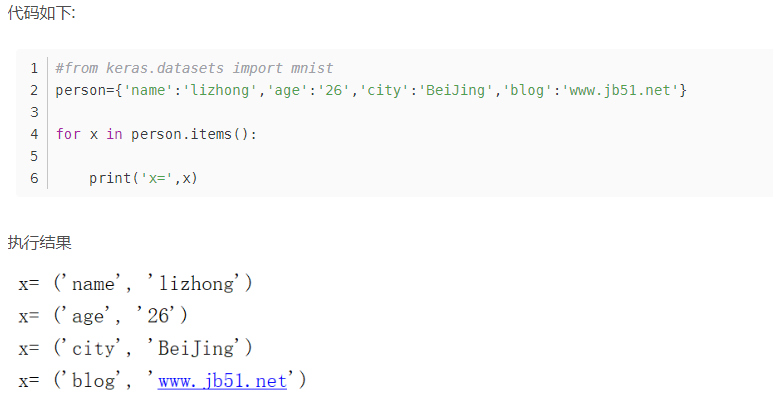Python zip()
zip() 函数用于将可迭代的对象作为参数,将对象中对应的元素打包成一个个元组,然后返回由这些元组组成的列表。
https://www.runoob.com/python/python-func-zip.html

Python索引
iloc根据位置 ,行号
loc根据index
https://www.cnblogs.com/soloveu/p/10049096.html
python @ 函数装饰器
http://c.biancheng.net/view/2270.html
https://blog.csdn.net/u012759262/article/details/79749299
当程序使用“@函数”(比如函数 A)装饰另一个函数(比如函数 B)时,实际上完成如下两步:
将被修饰的函数(函数 B)作为参数传给 @ 符号引用的函数(函数 A)。
将函数 B 替换(装饰)成第 1 步的返回值
@staticmethod
python中的staticmethod 主要是方便将外部函数集成到类体中,美化代码结构,重点在不需要类实例化的情况下调用方法
如果你去掉staticmethod,在方法中加self也可以通过实例化访问方法也是可以集成代码
https://blog.csdn.net/u013066730/article/details/56670685
https://www.cnblogs.com/elie/p/5876210.html
assert 报告异常
assert condition
用来让程序测试这个condition,如果condition为false,那么raise一个AssertionError出来。逻辑上等同于:
if not condition:
raise AssertionError()
https://www.cnblogs.com/hezhiyao/p/7805278.html
train.csv中有 图片id, 图片url, landmark_id地标标签
itertools
迭代相关的一些函数
chain()可以把一组迭代对象串联起来,形成一个更大的迭代器
groupby()把迭代器中相邻的重复元素挑出来放在一起
https://www.liaoxuefeng.com/wiki/897692888725344/983420006222912
python中pip 安装、升级、升级固定的包
https://blog.csdn.net/qq_15260769/article/details/80731407
pip install 安装包名
pip install --upgrade 要升级的包名
pip uninstall 要卸载的包名
pip install --ignore-installed 要强制升级的包名
终端运行python代码:
关闭命令行窗口的快捷键如下:Ctrl + d
进入python环境:在命令行中直接输入python即进入了python的编辑环境。进入环境后最明显的提示是:光标由~$变成>>>。
退出python环境:使用ctrl +d的方式退出python环境。回到命令行环境。
在python环境中输入多行函数:在语句的末尾输入英文的;即可实现换行。
例如:
def weight_variable(shape):
initial = tf.truncated_normal(shape, stddev=0.1);
return tf.Variable(initial);
注意:输入函数块时注意缩进
Python显示图像:
import matplotlib.pyplot as plt
plt.imshow(img)
Python|list,dict和DataFrame之间的相互转换
https://www.jianshu.com/p/22da8bb6c568
Python Dataframe转List
https://www.cnblogs.com/wq14061023/p/9002281.html
from pandas import read_csv
dataframe = read_csv(r'url', nrows = 86400, usecols = [0,], engine='python')
#nrows:读取行数,usecols=[n,]:仅读取第n列,usecols=[a,b,c]:读取a、b、c列
dataset = dataframe.values
List = []
for k in dataset:
for j in k:
List.append(j)
print(dataframe[0:3])
print(dataset[0:3])
print(List[0:3])
python字符串查找的四种方法
https://blog.csdn.net/tan197/article/details/82708553
python查找元素在列表中位置
p=list.index(value)
list为列表的名字
value为查找的值
p为value在list的位置
Python统计列表元素出现次数
https://blog.csdn.net/weixin_40604987/article/details/79292493
def all_list(arr):
result = {}
for i in set(arr):
result[i] = arr.count(i)
return result
# 结果:{0: 1, 1: 2, 2: 3, 3: 2}
查看list的shape
print(np.array(dict_landmark_unique).shape)
keys = sorted(dict_landmark_unique, key=lambda k: dict_landmark_unique[k],reverse= True)
print(item,dict_landmark_unique[item])
python的CSV文件读写 和 DataFrame
https://blog.csdn.net/bq_cui/article/details/81274202
https://www.cnblogs.com/wqpkita/p/7285418.html
https://blog.csdn.net/baidu_33718858/article/details/83758878
## submission
sample_submission = pd.read_csv('../dataset/retrieval_sample_submission.csv')
print("make sure the submmison rows: ", len(sample_submission))
test_id_list = sample_submission.id
ids = []
images = []
for ind, test in enumerate(test_image_id):
ids.append(test)
pred = all_predictions[ind]
tmp = [str(name) for name in pred[:100]]
images.append(" ".join(tmp))
submission = pd.DataFrame({'id': ids, 'images': images})
target = pd.DataFrame({"id":test_id_list})
submission = pd.merge(target, submission, how='left', on='id')
submission.to_csv("submission_retrieve_QE.csv", index=False, columns=['id', 'images'])
python 把几个DataFrame合并成一个DataFrame——merge,append,join,conca
https://blog.csdn.net/qq_42707449/article/details/81116656
ids_df = pd.DataFrame({"id": ids})
images_df = pd.DataFrame({"images": images})
submission = pd.concat([ids_df, images_df], axis=1)
python3中argparse模块
https://www.cnblogs.com/dengtou/p/8413609.html
1、定义:argparse是python标准库里面用来处理命令行参数的库
2、命令行参数分为位置参数和选项参数:
位置参数就是程序根据该参数出现的位置来确定的
如:[root@openstack_1 /]# ls root/ #其中root/是位置参数
选项参数是应用程序已经提前定义好的参数,不是随意指定的
如:[root@openstack_1 /]# ls -l # -l 就是ls命令里的一个选项参数
3、使用步骤:
(1)import argparse 首先导入模块
(2)parser = argparse.ArgumentParser() 创建一个解析对象
(3)parser.add_argument() 向该对象中添加你要关注的命令行参数和选项
(4)parser.parse_args() 进行解析
python 复制/移动文件
https://www.cnblogs.com/iois/p/7258686.html
import os,shutil
def mymovefile(srcfile,dstfile):
if not os.path.isfile(srcfile):
print "%s not exist!"%(srcfile)
else:
fpath,fname=os.path.split(dstfile) #分离文件名和路径
if not os.path.exists(fpath):
os.makedirs(fpath) #创建路径
shutil.move(srcfile,dstfile) #移动文件
print "move %s -> %s"%( srcfile,dstfile)
def mycopyfile(srcfile,dstfile):
if not os.path.isfile(srcfile):
print "%s not exist!"%(srcfile)
else:
fpath,fname=os.path.split(dstfile) #分离文件名和路径
if not os.path.exists(fpath):
os.makedirs(fpath) #创建路径
shutil.copyfile(srcfile,dstfile) #复制文件
print "copy %s -> %s"%( srcfile,dstfile)
srcfile='/Users/xxx/git/project1/test.sh'
dstfile='/Users/xxx/tmp/tmp/1/test.sh'
mymovefile(srcfile,dstfile)
python tolist()方法
https://www.cnblogs.com/Aaron12/p/9042687.html
https://blog.csdn.net/lilong117194/article/details/78437224
https://blog.csdn.net/nageaixiaodenanhai/article/details/79828895
但是当矩阵是一维的时候,就不同了,所以一维矩阵经常会有tolist()[0]
>>> from numpy import *
>>> a1 = [[1,2,3],[4,5,6]] #列表
>>> a2 = array(a1) #数组
>>> a2
array([[1, 2, 3],
[4, 5, 6]])
>>> a3 = mat(a1) #矩阵
>>> a3
matrix([[1, 2, 3],
[4, 5, 6]])
>>> a4 = a2.tolist()
>>> a4
[[1, 2, 3], [4, 5, 6]]
>>> a5 = a3.tolist()
>>> a5
[[1, 2, 3], [4, 5, 6]]
>>> a4 == a5
True
Python for和枚举和lambda
list_pre_submission = [pre_submission.iloc[i, :] for i in range(len(pre_submission))]

locations_2_to_use = np.array([locations_2[i,] for i in range(num_features_2)
if indices[i] != num_features_1])

枚举enumerate
for ind, test in enumerate(test_image_id):
ids.append(test)
pred = all_predictions[ind]
tmp = [str(name) for name in pred[:100]]
images.append(" ".join(tmp))
Tqdm python进度条包
https://blog.csdn.net/zkp_987/article/details/81748098
python学习笔记——multiprocessing 多进程组件 进程池Pool
https://www.cnblogs.com/gengyi/p/8620853.html
在使用Python进行系统管理时,特别是同时操作多个文件目录或者远程控制多台主机,并行操作可以节约大量时间,如果操作的对象数目不大时,还可以直接适用Process类动态生成多个进程,几十个尚可,若上百个甚至更多时,手动限制进程数量就显得特别繁琐,此时进程池就显得尤为重要。
进程池Pool类可以提供指定数量的进程供用户调用,当有新的请求提交至Pool中时,若进程池尚未满,就会创建一个新的进程来执行请求;若进程池中的进程数已经达到规定的最大数量,则该请求就会等待,直到进程池中有进程结束,才会创建新的进程来处理该请求。
进程池不用频繁创建和销毁进程
pickle库
https://www.php.cn/python-tutorials-372984.html
为什么需要序列化和反序列化这一操作呢?
- 便于存储。序列化过程将文本信息转变为二进制数据流。这样就信息就容易存储在硬盘之中,当需要读取文件的时候,从硬盘中读取数据,然后再将其反序列化便可以得到原始的数据。在Python程序运行中得到了一些字符串、列表、字典等数据,想要长久的保存下来,方便以后使用,而不是简单的放入内存中关机断电就丢失数据。python模块大全中的Pickle模块就派上用场了,它可以将对象转换为一种可以传输或存储的格式。
- loads()函数执行和load() 函数一样的反序列化。取代接受一个流对象并去文件读取序列化后的数据,它接受包含序列化后的数据的str对象, 直接返回的对象
python多线程
https://www.cnblogs.com/pythonxiaokang/p/5606003.html
进程与线程之间的关系
线程是属于进程的,线程运行在进程空间内,同一进程所产生的线程共享同一内存空间,当进程退出时该进程所产生的线程都会被强制退出并清除。线程可与属于同一进程的其它线程共享进程所拥有的全部资源,但是其本身基本上不拥有系统资源,只拥有一点在运行中必不可少的信息(如程序计数器、一组寄存器和栈)。
进程池Pool的imap方法
https://www.jianshu.com/p/4c4ca5bccc09
iter = pool.imap(fn, data)
python异常处理
https://www.runoob.com/python/python-exceptions.html
try:
<语句> #运行别的代码
except <名字>:
<语句> #如果在try部份引发了'name'异常
except <名字>,<数据>:
<语句> #如果引发了'name'异常,获得附加的数据
else:
<语句> #如果没有异常发生
Python item()
https://blog.csdn.net/weixin_38664232/article/details/90763042
item()方法把字典中每对key和value组成一个元组,并把这些元组放在列表中返回。
key接收了字典的key,value接收了字典的value值
#from keras.datasets import mnist
person={'name':'lizhong','age':'26','city':'BeiJing','blog':'www.jb51.net'}
for key,value in person.items():
print('key=',key,'value=',value)


如果只有一个参数接收
#from keras.datasets import mnist
person={'name':'lizhong','age':'26','city':'BeiJing','blog':'www.jb51.net'}
for x in person.items():
print('x=',x)

也可以打包
dict_id2landmark = {id: landmark for id, landmark in zip(train_csv.id, train_csv.landmark_id)}
python查找列表中某个值的位置
p=list.index(value)
list为列表的名字
value为查找的值
p为value在list的位置
python numpy——.npy和.npz文件
https://www.cnblogs.com/Lilu-1226/p/9768368.html
1.npy文件——Numpy专用的二进制格式
np.load()和np.save()是读写磁盘数组数据的两个重要函数。使用时,数组会以未压缩的原始二进制格式保存在扩展名为.npy的文件中。
2.npz文件——压缩文件
扩展名为.npz的压缩文件,它包含多个与保存的数组对应的npy文件(由save()函数保存),文件名对应数组名
读取.npz文件时使用np.load()函数,返回的是一个类似于字典的对象,因此可以通过数组名作为关键字对多个数组进行访问
Python编程之numpy库函数in1d的使用
https://blog.csdn.net/qq_35751790/article/details/78660290
in1d函数与excel中vlookup函数和MATLAB中ismember函数有相似之处。其作用在于在序列B中寻找与序列A相同的值,并返回一逻辑值(True,False)或逻辑值构成的向量。具体例子见下文。
设mask为逻辑值向量,矩阵x的第一列为待查找向量,d为被查询向量(或值),即查找x中与d中指定元素相同的值,并返回逻辑值向量mask。mask是由一系列True和False值构成,True代表找到相同的值,而False代表没找到相同的值。演示如下:
mask= np.in1d(x.values[:,1],d[1],invert=False) ##x为DataFrame型数据,x.values[:,1]表示取第二列值
x_temp=x[mask]
python中删除list中某指定元素
https://blog.csdn.net/weixin_42814873/article/details/83377431
方法 代码 说明
del del L[i] ①根据索引删除;②删除索引范围内的元素;③删除整个列表。del操作没有返回值
pop list.pop(i) 根据索引删除,返回索引位置的元素
remove list.remove(value) 删除第一个符合条件的元素,注意不是根据索引删除
python判断目录是否存在,不存在创建一个新的
https://blog.csdn.net/jiangjiang_jian/article/details/80985362
import os
if not os.path.isdir(dir_name):
os.makedirs(dir_name)
os.mkdir()创建路径中的最后一级目录,而如果之前的目录不存在并且也需要创建的话,就会报错。
os.makedirs()创建多层目录,如果中间目录都不存在的话,会自动创建。
判断文件是否存在
https://www.cnblogs.com/jhao/p/7243043.html
if not os.path. exists(dir_name):
work
Python变量类型的强制转换
https://blog.csdn.net/yanyangjie/article/details/78329196
python路径拼接os.path.join()函数的用法
https://www.cnblogs.com/an-ning0920/p/10037790.html
os.path.join()函数:连接两个或更多的路径名组件
1.如果各组件名首字母不包含’/’,则函数会自动加上
2.如果有一个组件是一个绝对路径,则在它之前的所有组件均会被舍弃
3.如果最后一个组件为空,则生成的路径以一个’/’分隔符结尾
Demo1
import os
Path1 = 'home'
Path2 = 'develop'
Path3 = 'code'
Path10 = Path1 + Path2 + Path3
Path20 = os.path.join(Path1,Path2,Path3)
print ('Path10 = ',Path10)
print ('Path20 = ',Path20)
输出
Path10 = homedevelopcode
Path20 = homedevelopcode
python查看dataframe的头的信息
1df.head()
1
python中dataframe的切片
https://blog.csdn.net/yoonhee/article/details/76168253
df.iloc[0,0]
Python获取代码运行时间的几种方法
https://blog.csdn.net/asialee_bird/article/details/79673860
方法四:
#在 Unix 系统中,建议使用 time.time(),在 Windows 系统中,建议使用 time.clock()
#实现跨平台的精度性可以使用timeit.default_timer()
import timeit
start=timeit.default_timer()
#中间写代码块
end=timeit.default_timer()
print('Running time: %s Seconds'%(end-start))
#运行结果
#Running time: 2.31757675399 Seconds
python dataframe转置
df2 = pd.DataFrame(df.values.T, index=df.columns, columns=df.index)
https://blog.csdn.net/a19990412/article/details/90744905
python 返回对象的属性
https://www.cnblogs.com/klchang/p/7296058.html
dir() 函数
dir([object]) 会返回object所有有效的属性列表。
python字典排序,按key排序和按value排序---sorted()
>>> d
{'a': 5, 'c': 3, 'b': 4}
>>> d.items()
[('a', 5), ('c', 3), ('b', 4)]
字典的元素是成键值对出现的,字典的排序可用sorted,用关键字key指定排序依据的值--key或者value
按照值排序:
#把d.items()所对应的列表的每个元祖的第二个元素(value)传到lambda函数进行排序
>>> s=sorted(d.items(),key=lambda x:x[1])
>>> s
[('c', 3), ('b', 4), ('a', 5)]
按照key排序:
#把d.items()所对应的列表的每个元祖的第一个元素(key)传到lambda函数进行排序
>>> s=sorted(d.items(),key=lambda x:x[0])
>>> s
[('a', 5), ('b', 4), ('c', 3)]
python list 怎么查出一个元素的所有位置
https://zhidao.baidu.com/question/390550100266645085.html?qbl=relate_question_2&word=python%20%B7%B5%BB%D8%D6%B8%B6%A8%D4%AA%CB%D8%CB%F9%D4%DA%B5%C4%CB%F9%D3%D0%CE%BB%D6%C3
def find_all_index(arr,item):
return [i for i,a in enumerate(arr) if a==item]
if __name__=='__main__':
print(find_all_index([1,2,3,2,2],2))
最后
以上就是冷傲小甜瓜最近收集整理的关于python常用操作总结的全部内容,更多相关python常用操作总结内容请搜索靠谱客的其他文章。








发表评论 取消回复